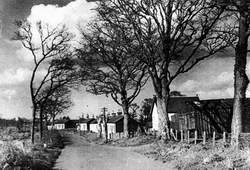Abandoned Communities ..... Ayrshire
If you continue south on the B742 from the site of Burnbrae and then turn left after about a mile on to a minor road towards Springs and Stair, you will pass the site of Woodside in a field on the right hand side, at OS 421223. Woodside comprised four rows of houses, a total of 37 dwellings.
Woodside featured in the 1913 report on Ayrshire Miners’ Rows by McKerrell and Brown. Their report on Woodside was no less critical than what they had had to say about Glenbuck. 28 of the houses had two rooms, the rest had one room. There were not enough wash houses, closets, or ashpits, and they were of poor quality. Each dry closet, for example, had to be shared between three houses, none of them had doors, and some were “unspeakably dirty”. It was noted that the men take a keen interest in the gardens behind the houses. The report ended with the comment that “the people here are of a good type, and deserve better accommodation.”
The section of the report on Woodside can be read on the Ayrshire History website.
Section Four of the report on Ayrshire Miners’ Rows, entitled Remedies, begins by pointing out the disadvantages of tied accommodation. Tenants living in houses owned by their employer will be more reluctant to complain about the lack of facilities or their poor state of repair. Anyone who loses their job in the mine is likely to be obliged to leave their accommodation as well. In addition the report asserts that the existing public health laws were totally ineffective. The main recommendation is that local authorities should take on greater responsibility for providing housing. The responsibility would include building houses for working people and letting them at a subsidised rent. The minimum requirement for each house would be three rooms, a scullery, and a bathroom, with a water closet and coalhouse attached to each house.
The Housing and Town Planning Act 1919 gave local authorities the power to provide council housing. In Ayrshire 26,000 council houses were built between 1919 and 1948, and another 46,000 in the following 20 years.
At Woodside, however, long before the inhabitants were given a chance to move to council houses, they were offered an opportunity to buy their houses. In 1926 the houses were sold by the mining company William Baird and Co. to the estate of Mrs Crystabel Mary Hamilton. Then in February 1928 they were bought by the occupants. The Valuation Roll for 1929-30 shows that apart from four houses that were uninhabitable, all the houses were owner occupied. In eight cases houses were listed in adjacent pairs under one name. I assume that these were houses that had been amalgamated to form a single dwelling. Three adjacent houses, No. 25, 26, and 27, were all bought by Hugh Shimmons. I wonder whether they may have been bought for letting purposes as Hugh Shimmons also owned No. 21-22. All but one of the dwellings were occupied by miners or men who had other mine occupations such as repairer, bottomer, or fireman. No 3-4 was owned by Mrs Isabella Lang, whose occupation is not given.
The Settlement Statement for No. 13-14, purchased by Mr Thomas Stewart, has been reproduced in Denholm T Reid, Old Annbank and Mossblown, Stenlake Publishing, 2005. The purchase price was £12 10s, but rates and other expenses cost Thomas Stewart an extra £4 4s 9d.
Woodside featured in the 1913 report on Ayrshire Miners’ Rows by McKerrell and Brown. Their report on Woodside was no less critical than what they had had to say about Glenbuck. 28 of the houses had two rooms, the rest had one room. There were not enough wash houses, closets, or ashpits, and they were of poor quality. Each dry closet, for example, had to be shared between three houses, none of them had doors, and some were “unspeakably dirty”. It was noted that the men take a keen interest in the gardens behind the houses. The report ended with the comment that “the people here are of a good type, and deserve better accommodation.”
The section of the report on Woodside can be read on the Ayrshire History website.
Section Four of the report on Ayrshire Miners’ Rows, entitled Remedies, begins by pointing out the disadvantages of tied accommodation. Tenants living in houses owned by their employer will be more reluctant to complain about the lack of facilities or their poor state of repair. Anyone who loses their job in the mine is likely to be obliged to leave their accommodation as well. In addition the report asserts that the existing public health laws were totally ineffective. The main recommendation is that local authorities should take on greater responsibility for providing housing. The responsibility would include building houses for working people and letting them at a subsidised rent. The minimum requirement for each house would be three rooms, a scullery, and a bathroom, with a water closet and coalhouse attached to each house.
The Housing and Town Planning Act 1919 gave local authorities the power to provide council housing. In Ayrshire 26,000 council houses were built between 1919 and 1948, and another 46,000 in the following 20 years.
At Woodside, however, long before the inhabitants were given a chance to move to council houses, they were offered an opportunity to buy their houses. In 1926 the houses were sold by the mining company William Baird and Co. to the estate of Mrs Crystabel Mary Hamilton. Then in February 1928 they were bought by the occupants. The Valuation Roll for 1929-
The Settlement Statement for No. 13-
Six
The village of Woodside
The present occupants of the field where Woodside used to be

